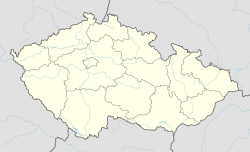Bogumin
| Bohumín | |||
|---|---|---|---|
| Town | |||

Masaryk Square and the town hall in Nový Bohumín
|
|||
|
|||
| Location in the Czech Republic | |||
| Coordinates: 49°54′13″N 18°21′16″E / 49.90361°N 18.35444°E | |||
| Country | Czech Republic | ||
| Region | Moravian-Silesian | ||
| District | Karviná | ||
| First mentioned | 1256 | ||
| Town parts | |||
| Government | |||
| • Mayor | Petr Vícha (ČSSD) | ||
| Area | |||
| • Total | 31.02 km2 (11.98 sq mi) | ||
| Elevation | 198 m (650 ft) | ||
| Population (1 August 2009) | |||
| • Total | 22,800 | ||
| • Density | 740/km2 (1,900/sq mi) | ||
| Postal code | 435 81 to 935 81 | ||
| Website | http://www.mesto-bohumin.cz/ | ||
Bohumín (Czech pronunciation: [ˈboɦumiːn]; Polish: Bogumin , German: Oderberg) is a town in Karviná District, Moravian-Silesian Region, Czech Republic on the border with Poland. The confluence of the Oder (Odra) and Olza rivers is situated just north of the town. The town lies in the historical region of Cieszyn Silesia.
Bohumín consists of Old Bohumín and industrial New Bohumín, while several villages are administratively part of the town. The majority of citizens are Czech; many citizens have Polish ancestry, although the Polish minority in Bohumín is small. Before World War II, the town was inhabited by a large German community, nowadays the city is known as one of the largest community of Romani People in the Czech republic.
The town was first mentioned in a border agreement between Władysław Opolski, the duke of Opole and Racibórz and Ottokar II of Bohemia, in 1256 as Bogun (today's Old Bohumín). Historical documents regarding the first centuries of the town are scarce. King Louis II granted the town and château of Bohumín to George, Margrave of Brandenburg-Ansbach in 1523. The town began to develop during rule by the House of Hohenzollern, although further development of Bogumin was halted by frequent epidemics of bubonic plague and floodings of the Olza. It was officially known in German as Oderberg, and by the end of the 16th century the majority of citizens followed Protestantism. The successor after the Hohenzollerns in 1620 was Lazar Henckel, whose family of bankers and entrepreneurs hailed from Habsburg-ruled Hungary. In 1624 only 138 permanent residents lived in the town. After defeating Maria Theresa of Austria during the Silesian Wars, King Frederick II of Prussia annexed most of Silesia, although Oderberg remained in Austrian Silesia. The town successively became part of the Austrian Empire (1804) and Austria-Hungary (1867).
...
Wikipedia



